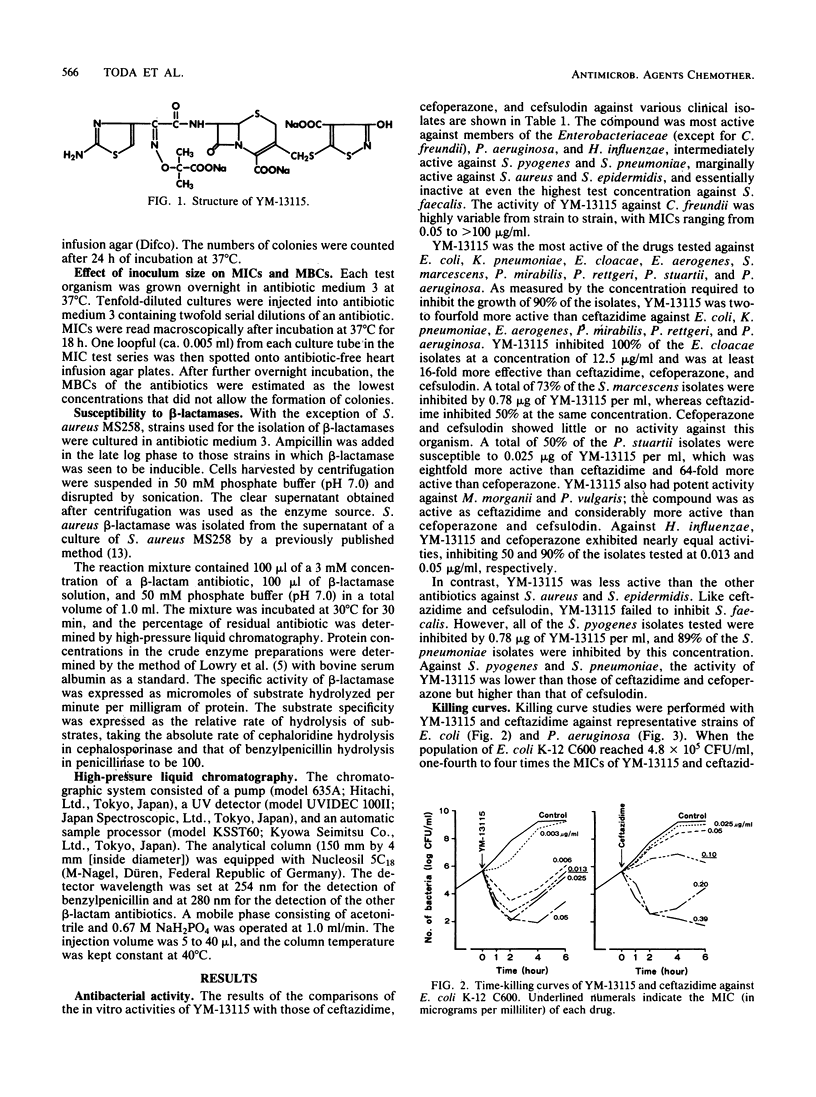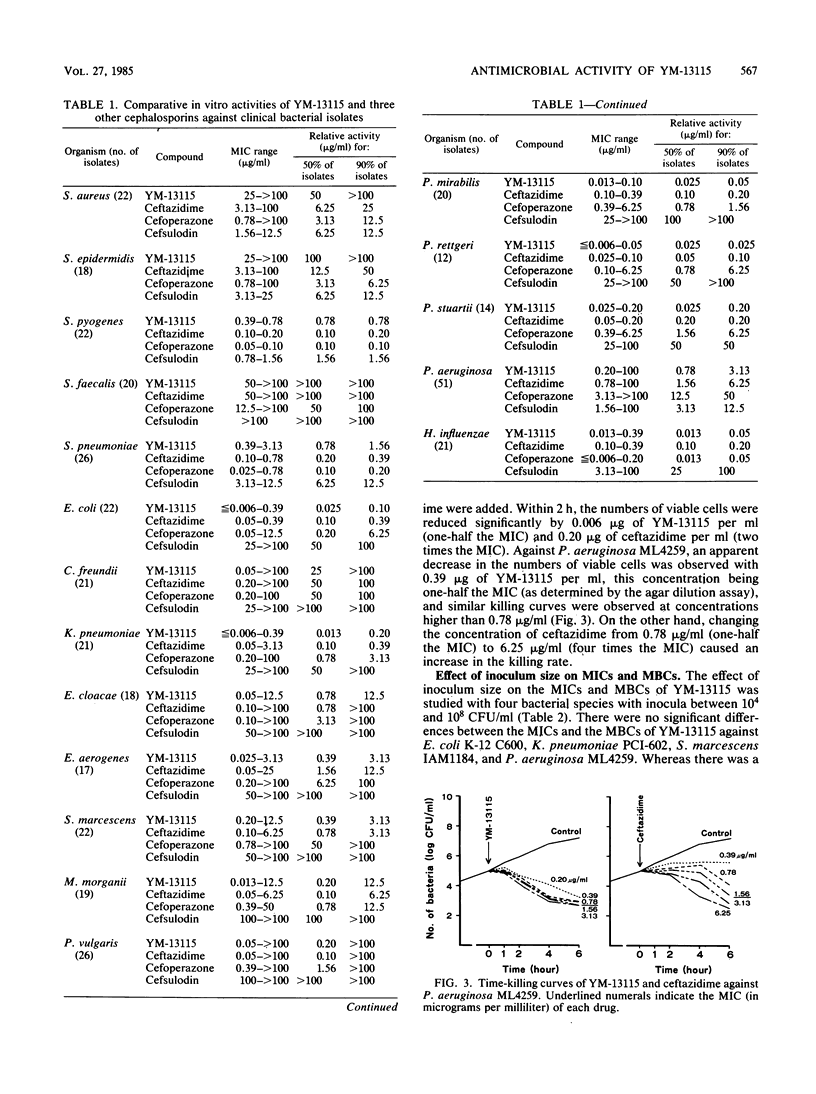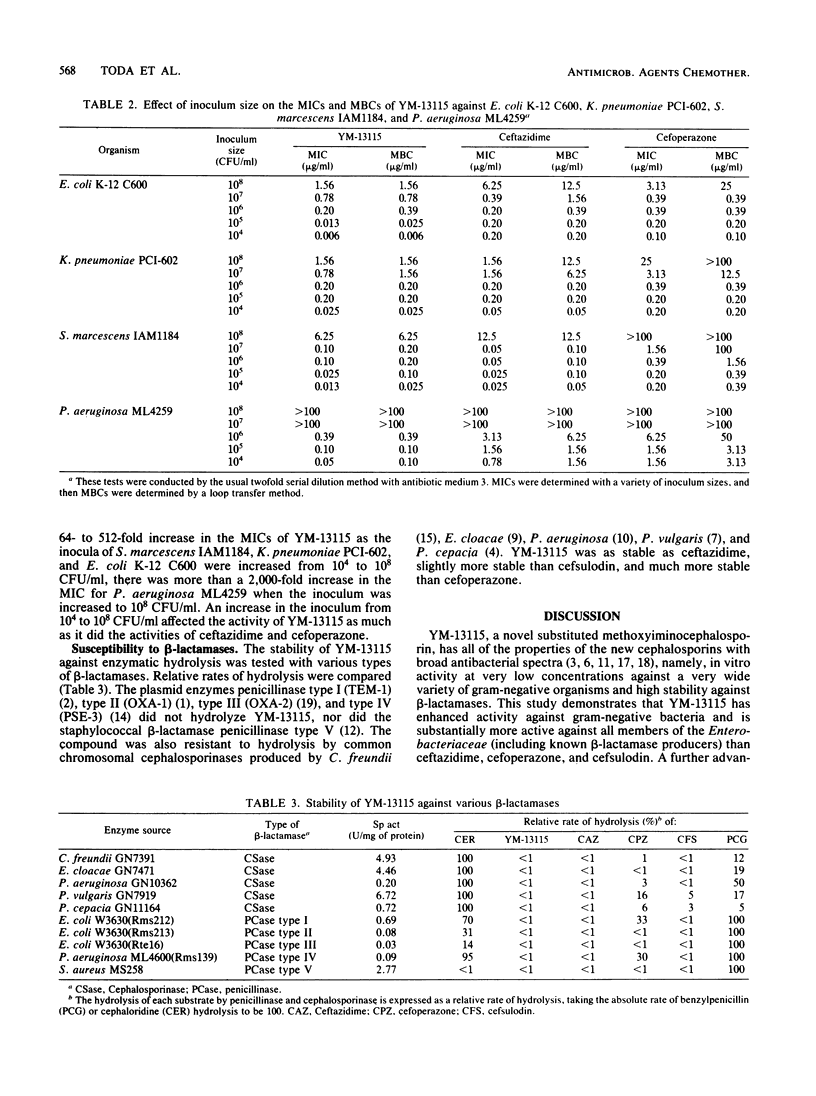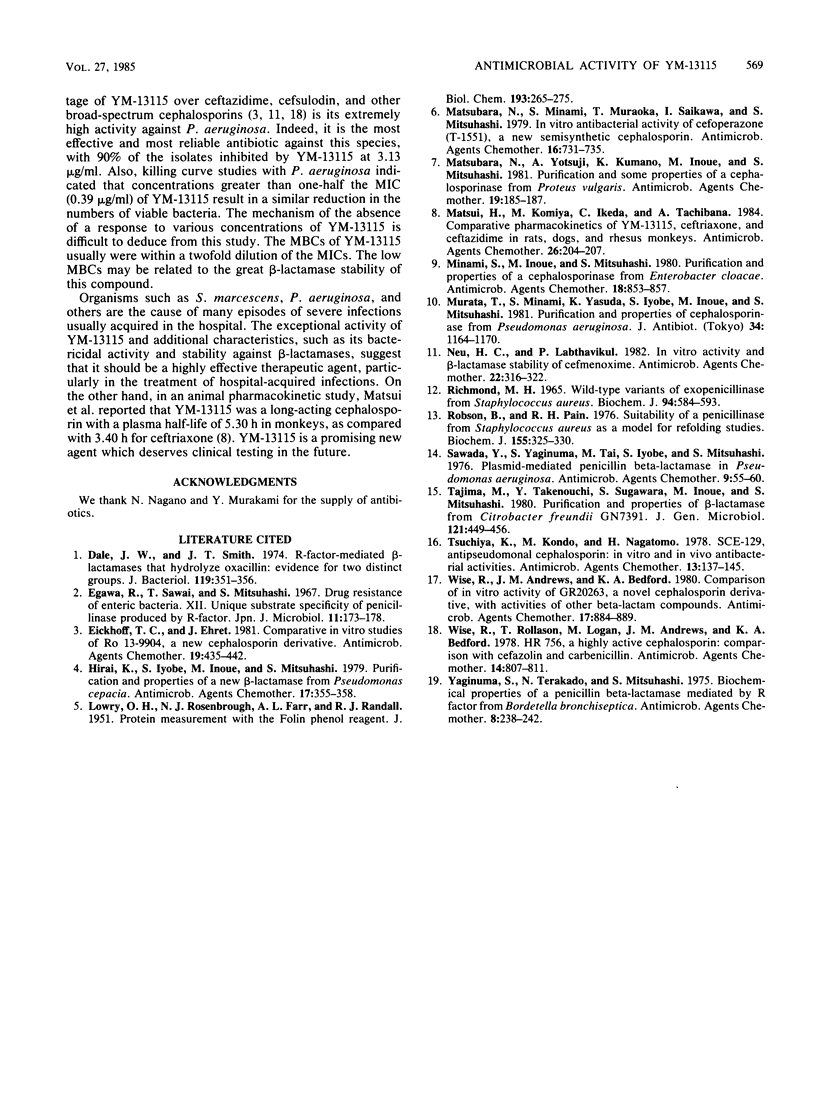Abstract
The in vitro antibacterial activities of YM-13115, a new parenteral cephalosporin, were compared with those of ceftazidime, cefoperazone, and cefsulodin. The compound was highly active against the common members of the Enterobacteriaceae and 2 to 256 times more active than cefoperazone. YM-13115 was as active as ceftazidime against Citrobacter freundii, Proteus vulgaris, and Morganella morganii and two to four times more active than ceftazidime against Escherichia coli, Klebsiella pneumoniae, Enterobacter cloacae, Enterobacter aerogenes, Serratia marcescens, Proteus mirabilis, Providencia rettgeri, and Providencia stuartii. The activity of YM-13115 against Pseudomonas aeruginosa (with MICs of 0.78 and 3.13 micrograms/ml for 50 and 90% of the isolates, respectively) was ca. 2 times that of ceftazidime, 4 times that of cefsulodin, and 16 times that of cefoperazone. Against Haemophilus influenzae YM-13115 was more active than ceftazidime. YM-13115 was less active than ceftazidime, cefoperazone, and cefsulodin against Staphylococcus aureus and Staphylococcus epidermidis. The concentrations of YM-13115 required to inhibit the growth of 90% of the isolates of Streptococcus pyogenes and Streptococcus pneumoniae were 0.78 and 1.56 microgram/ml, respectively, but concentrations above 100 micrograms/ml were required to inhibit Streptococcus faecalis. YM-13115 was not hydrolyzed by the common plasmid and chromosomal beta-lactamases. YM-13115 is extremely active against P. aeruginosa and members of the Enterobacteriaceae.
Full text
PDF




Selected References
These references are in PubMed. This may not be the complete list of references from this article.
- Dale J. W., Smith J. T. R-factor-mediated beta-lactamases that hydrolyze oxacillin: evidence for two distinct groups. J Bacteriol. 1974 Aug;119(2):351–356. doi: 10.1128/jb.119.2.351-356.1974. [DOI] [PMC free article] [PubMed] [Google Scholar]
- Eickhoff T. C., Ehret J. Comparative in vitro studies of Ro 13-9904, a new cephalosporin derivative. Antimicrob Agents Chemother. 1981 Mar;19(3):435–442. doi: 10.1128/aac.19.3.435. [DOI] [PMC free article] [PubMed] [Google Scholar]
- Hirai K., Iyobe S., Inoue M., Mitsuhashi S. Purification and properties of a new beta-lactamase from Pseudomonas cepacia. Antimicrob Agents Chemother. 1980 Mar;17(3):355–358. doi: 10.1128/aac.17.3.355. [DOI] [PMC free article] [PubMed] [Google Scholar]
- LOWRY O. H., ROSEBROUGH N. J., FARR A. L., RANDALL R. J. Protein measurement with the Folin phenol reagent. J Biol Chem. 1951 Nov;193(1):265–275. [PubMed] [Google Scholar]
- Matsubara N., Minami S., Muraoka T., Saikawa I., Mitsuhashi S. In vitro antibacterial activity of cefoperazone (T-1551), a new semisynthetic cephalosporin. Antimicrob Agents Chemother. 1979 Dec;16(6):731–735. doi: 10.1128/aac.16.6.731. [DOI] [PMC free article] [PubMed] [Google Scholar]
- Matsubara N., Yotsuji A., Kumano K., Inoue M., Mitsuhashi S. Purification and some properties of a cephalosporinase from Proteus vulgaris. Antimicrob Agents Chemother. 1981 Jan;19(1):185–187. doi: 10.1128/aac.19.1.185. [DOI] [PMC free article] [PubMed] [Google Scholar]
- Matsui H., Komiya M., Ikeda C., Tachibana A. Comparative pharmacokinetics of YM-13115, ceftriaxone, and ceftazidime in rats, dogs, and rhesus monkeys. Antimicrob Agents Chemother. 1984 Aug;26(2):204–207. doi: 10.1128/aac.26.2.204. [DOI] [PMC free article] [PubMed] [Google Scholar]
- Minami S., Inoue M., Mitsuhashi S. Purification and properties of a cephalosporinase from Enterobacter cloacae. Antimicrob Agents Chemother. 1980 Dec;18(6):853–857. doi: 10.1128/aac.18.6.853. [DOI] [PMC free article] [PubMed] [Google Scholar]
- Murata T., Minami S., Yasuda K., Iyobe S., Inoue M., Mitsuhashi S. Purification and properties of cephalosporinase from Pseudomonas aeruginosa. J Antibiot (Tokyo) 1981 Sep;34(9):1164–1170. doi: 10.7164/antibiotics.34.1164. [DOI] [PubMed] [Google Scholar]
- Neu H. C., Labthavikul P. In vitro activity and beta-lactamase stability of cefmenoxime. Antimicrob Agents Chemother. 1982 Aug;22(2):316–322. doi: 10.1128/aac.22.2.316. [DOI] [PMC free article] [PubMed] [Google Scholar]
- RICHMOND M. H. WILD-TYPE VARIANTS OF EXOPENICILLINASE FROM STAPHYLOCOCCUS AUREUS. Biochem J. 1965 Mar;94:584–593. doi: 10.1042/bj0940584. [DOI] [PMC free article] [PubMed] [Google Scholar]
- Robson B., Pain R. H. The mechanism of folding of globular proteins. Suitability of a penicillinase from Staphylococcus Aureus as a model for refolding studies. Biochem J. 1976 May 1;155(2):325–330. doi: 10.1042/bj1550325. [DOI] [PMC free article] [PubMed] [Google Scholar]
- Sawada Y., Yaginuma S., Tai M., Iyobe S., Mitsuhashi S. Plasmid-mediated penicillin beta-lactamases in Pseudomonas aeruginosa. Antimicrob Agents Chemother. 1976 Jan;9(1):55–60. doi: 10.1128/aac.9.1.55. [DOI] [PMC free article] [PubMed] [Google Scholar]
- Tajima M., Takenouchi Y., Sugawara S., Inoue M., Mitsuhashi S. Purification and properties of chromosomally mediated beta-lactamase from Citrobacter freundii GN7391. J Gen Microbiol. 1980 Dec;121(2):449–456. doi: 10.1099/00221287-121-2-449. [DOI] [PubMed] [Google Scholar]
- Tsuchiya K., Kondo M., Nagatomo H. SCE-129, antipseudomonal cephalosporin: in vitro and in vivo antibacterial activities. Antimicrob Agents Chemother. 1978 Feb;13(2):137–145. doi: 10.1128/aac.13.2.137. [DOI] [PMC free article] [PubMed] [Google Scholar]
- Wise R., Andrews J. M., Bedford K. A. Comparison of in vitro activity of GR 20263, a novel cephalosporin derivative, with activities of other beta-lactam compounds. Antimicrob Agents Chemother. 1980 May;17(5):884–889. doi: 10.1128/aac.17.5.884. [DOI] [PMC free article] [PubMed] [Google Scholar]
- Wise R., Rollason T., Logan M., Andrews J. M., Bedford K. A. HR 756, a highly active cephalosporin: comparison with cefazolin and carbenicillin. Antimicrob Agents Chemother. 1978 Dec;14(6):807–811. doi: 10.1128/aac.14.6.807. [DOI] [PMC free article] [PubMed] [Google Scholar]
- Yaginuma S., Terakado N., Mitsuhashi S. Biochemical properties of a penicillin beta-lactamase mediated by R factor from Bordetella bronchiseptica. Antimicrob Agents Chemother. 1975 Sep;8(3):238–242. doi: 10.1128/aac.8.3.238. [DOI] [PMC free article] [PubMed] [Google Scholar]


